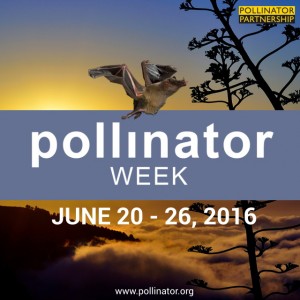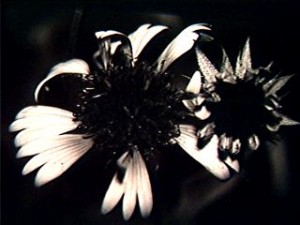Pollinator week — coming right up on June 20 — celebrates all pollinators. There’s honey bees, of course, but also native bees. In fact, NYS IPM-funded research has counted 104 known species alone in New York’s orchards. Of course, bees pollinate more than just orchards, and 450 species all told call New York home — including two on New York’s endangered species list. Collectively these bees contribute upward of $9 billion in pollination services to New York’s economy — and we’re not even talking the value of honey itself.

For sure: we can’t leave out butterflies, moths, flies (think flower flies, hover flies, and more), wasps, beetles, and hummingbirds. If we lived in the Southwest, we’d be thanking bats as well.
Now, though, let’s focus on bees, since entomologists have discovered so many cool things about how flowers attract bees — and vice versa. Those scientists have found an array of captivating “who’d a thunk it” ways these symbiotic mutualists have evolved to do each other right.
Yet before we go down that track, a little detour — pointing you to info from NYS IPM’s “Protecting Pollinators” conference. Start with the first two: Emma Mullen’s fascinating talk and superb visuals, and Scott McArt’s tour of Cornell’s research, now in full swing.
OK, back to our symbiotic mutualists — the blossoms and the bees. Examples? Consider color. Bees don’t see red, but they do see ultraviolet. In fact, many flowers equip themselves with “come hither” ultraviolet landing platforms, landing strips, or both.

And how about the electric fields wafting up from flower petals? “Everyone knows that bees buzz around flowers in their quest for nectar,” reports Marc Lallanilla at LiveScience. “But scientists have now learned that flowers are buzzing right back — with electricity.”

Why? That electric charge advertises — you guessed it — a nectar source. On the other hand, a blossom just depleted of nectar needs to recharge its nectar reserves. So it emits a different signal, one that alerts the bees to just fly on by. After all, bees can learn. And they don’t have time to waste visiting pretty flowers if the nectar is gone. Bees might learn to ignore a flower with a reputation for false advertising (as it were) — even after the flower had topped off its tank.
And then … there’s also “buzz pollination” where flowers wait till a bee buzzes at the right frequency, then reward it with a cache of pollen. True, these flowers don’t offer free drinks (that would be nectar) as a reward. But the pollen they offer is, for some species of bees, reward enough. After all, it’s what they feed their young. Note that we said “for some species.” Bumble bees are great buzz pollinators, as are many native bees. But honey bees never learned that trick. (The science behind it ? Science Direct and Journal of the Kansas Entomological Society.)
Planting potatoes, tomatoes, eggplants, and peppers (all relatives in the Solanaceae family) or pumpkins, zucchinis, and blueberries? Know that native bees are your go-to experts in buzz pollination. (If you live, say, in a high-rise with a window gardens and no access to rooftop beekeepers, you could buy a VegiBee pollinator and do it yourself.)
Of course, not every flower does any or all of the above. If you want to do right by bees, think before you plant and focus on these four things:
- Plant for continuous bloom — pollinators don’t get down time; your garden shouldn’t either. Is your yard tiny? Try collaborating with your neighbors and think of it as yet another form of symbiotic mutualism.
- Is this a bee-friendly flower? Example: if you love roses, plant those old-timey kinds with the simple “single” flowers. Densely clustered petals just get in the way. (While roses provide little in the way of nectar, they’ve got pollen to spare.)
- Cluster your plants. Groups of long-blooming flowers, rather than single plants scattered here and there, offer bees a better use of their time and energy.
- Nectar sounds juicy, but pollinators need straight-up water too. Just be sure to empty your bird feeder or plant saucer every few days. Yes, even mosquitoes pollinate flowers. But that’s not reason enough to invite them into your yard. (Float a piece of wood in the water to give bees a safe landing place.)
What to plant? Variety is the spice of life.
Trees and shrubs: oak, cherry, willow, basswood, birch, tulip poplar, crabapple, blueberry, red maple, pine, hawthorn, linden, redbud, arrowwood viburnum, chokecherry, Rhododendron canadense, spicebush, gray dogwood, serviceberry, New Jersey tea, buttonbush, summersweet, Virginia sweetspire, American witchhazel.
Perennials for sun: aster, goldenrod, sunflower, Joe Pye weed, violet (also does well in shade), hardy geranium, black-eyed Susan, iris, milkweed, penstemon, phlox, threadleaf coreopsis, bee balm, cardinal flower, mountain mint, purple coneflower, columbine, liatris.
Perennials for shade: woodland phlox, blue lobelia, jack-in-the-pulpit, indian pink, wood aster, Dutchman’s breeches, violets (also does well in sun).
Weeds: OK, so you don’t need to plant dandelions; they plant themselves. They aren’t native and some people can’t stand them. But they’re here and they provide crucial early-season food for bees.
So there you have it. You too can protect pollinators.